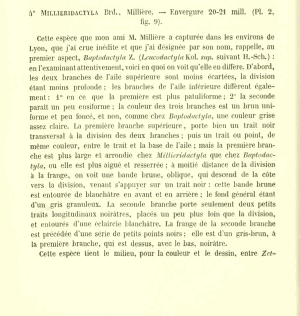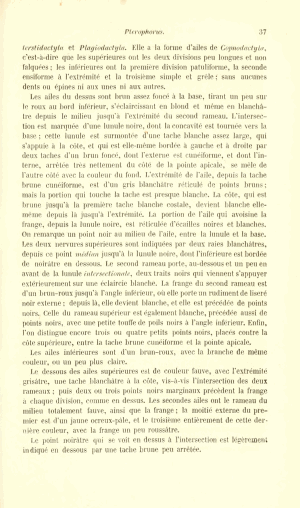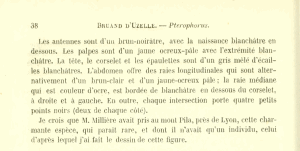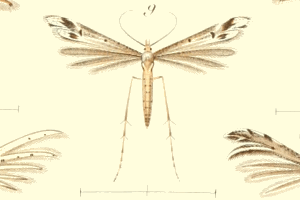2. Diagnose
2.1. Erstbeschreibung
3. Biologie
3.1. Nahrung der Raupe
- [Saxifragaceae:] Saxifraga continentalis (Moos-Steinbrech)
- [Saxifragaceae:] Saxifraga hypnoides (Moos-Steinbrech
- [Saxifragaceae:] Saxifraga prostii
- [Saxifragaceae:] Saxifraga granulata ? (Knöllchen-Steinbrech ?)
Bruand d'Uzelle (1861) macht in seiner ausführlichen Erstbeschreibung von S. millieridactyla keinerlei Angaben zu den Präimaginalstadien.
Auch Fletcher & Pierce (1940: 28) kannten die Raupe nicht, als sie das Synonym Stenoptilia saxifragae beschrieben. Sie waren sich aber sicher: "S. saxifragae has not yet been bred but is certainly attached to Saxifraga spp. Mr Beirne notes (in litt., 3.viii.39) that "one female laid about 20 eggs in the box. When the larvae hatched out, about 23.vii, I put them on the tips of the Saxifrage leaves. They immediately went down the leaf and burrowed into it near its base, one or two larvae to each leaf. They are now eating their way upwards towards the tips of the leaves, forming brown blotches and galleries." Mr Beirne, to whom I am indebted for the material described, will doubtless succeed in completing its life-history. It is stated to be abundant in gardens in all parts of County Dublin." Und dann stellten sie vergleichend fest: "On the Continent S. pelidnodactyla, Stein 1837, also feeds on Saxifrage but its genitalia are quite distinct from those of saxifragae [...].
Gielis (2003: 59) schreibt zur Raupennahrung: "The hostplants are Saxifraga continentalis Engler & Irmescher (Nel, 1986d; Nel & Gibeaux, 1990) S. granulata L. (Nel, 1986d) and S. hypnodes L. (Emmet, 1979). The larva feeds in the petioles of the leaves, later on the leaves. Pupation on the hostplant." Und bei Arenberger (2005: 72) heißt es ganz ähnlich: "Futterpflanzen: Saxifraga continentalis (Engler & Irmescher) D.A. Webb S. prostii Sternb., S. granulata L. - S. hypnodes L. (Emmet, 1979) [Saxifragaceae]. Raupe an den Blättern und Knospen.
Bei Nel & Gibeaux (1990: 137, 145-146) ist zu lesen: "Les découvertes successives, en 1988, de quatre nouvelles espèces de Stenoptilia inféodée à des saxifrages ne sont pas dues au hasard; tout d'abord, il fallait voir s'il existe en Corse, une espèce inféodée à une saxifrage "mousse", comme l'est sur le continent Stenoptilia millieridactyla Bruand d'Uzelle, 1859 (= saxifragae Fletcher, 1940, à Saxifraga continentalis (Engl. & Ym.) D.A. Webb [...] Le 22 août 1989, monsieur Jacques Picard et madame Marie-Louise Roman (in litteris) ont prisau Plan d'Aups, lieu dit "la Mine" (Var) et à Rougiers (Var), plusieurs exemplaires très frais de S. millieridactyla, dans des stations de Saxifraga continentalis, la plante-hôte. [...]". Da daraufhin bis zum 20. September weitere Falter gefunden wurden, wurde auf das Vorhandensein einer 2. Gen. geschlossen. Bei der Auflistung viele neuen Fundstellen heißt es zunächst: "D'autre part, depuis lètude sur les premiers états de S. millieridactyla (Nel, 1986), de nouvelles stations ont été découvertes [...] auch: "aux cascades d'Orgon, près du mont Aigoual, D 548, 1200 m ex larva sur Saxifraga prostii, en compagnie de S. cebennica n.sp."
(Autor: Erwin Rennwald)
4. Weitere Informationen
4.1. Abweichende Schreibweisen
- Stenoptilia millieridactylus (Bruand, 1861) [so z.B. in der Fauna Europaea]
4.2. Andere Kombinationen
- Pterophorus millieridactyla Bruand, 1861 [Originalkombination]
4.3. Synonyme
- Stenoptilia saxifragae Fletcher & Pierce, 1940
4.4. Taxonomie und Faunistik
Gielis (2003: 58-59) und Arenberger (2005: 71-72) sind sich einig: S. millieridactyla hat genau ein Synonym: Stenoptilia saxifragae Fletcher & Pierce, 1940. Die Art wurde aus Lyon in Frankreich beschrieben, das Synonym aus Irland. Bei Ersterem steht zur Verbreitung: "West and South-West Europe, bei Letzterem Nord-, West- und Südeuropa. Nordafrika. Und Letzterer listet zudem viele konkreten Fundorte aus Irland, England, Frankreich, Korsika, Spanien, Portugal, Marokko (Ifrane im Mittleren Atlas), Italien (Abruzzen, Gran Sasso), Norwegen (Vadsø) und Schweden (Torne Lapmark, Snuritjäkke) auf. Die Art wäre demnach recht weit verbreitet.
(Autor: Erwin Rennwald)
4.5. Literatur
- Arenberger, E. (2005): Microlepidoptera Palaearctica. Zwölfter Band. Pterophoridae. 3. Teilband. Platyptiliinae: Platyptiliini: Stenoptilia. — 191 S.; Keltern (Goecke & Evers).
- Erstbeschreibung: Bruand d'Uzelle (1861): Note sur quelques espèces du genre Pterophorus. — Annales de la Société entomologique de France. Quatrième série 1: 33-38, pl. 2. Paris.
- Beschreibung als Stenoptilia saxifragae: Fletcher, T.B. & F.N. Pierce (1940): A new Irish plume-moth (Lep., Alucit.), with a note on its genitalia. — The Entomologist's Record and Journal of Variation, 52 (3): 25-28. [Digitalisat auf biodiversitylibrary.org]
- Gielis, C. 2003. Pterophoroidea & Alucitoidea (Lepidoptera). World Catalogue of Insects, volume 4. — 198 S.; Stenstrup/DK (Apollo Books).
- Nel, J. (1986): Note sur les Stenoptilia français des Saxifrages. Quatrième contribution à la connaissance des premiers états des Pterophoridae. — Alexanor, 14 Supplement: [41]-[45]. Sekundärzitat]




![Vorkommen in Großbritannien [Agassiz, Beavan & Heckford (2013): Checklist of the Lepidoptera of the British Isles]](/res/img/flag/gb.gif)
![Vorkommen in Irland einschließlich Nordirland [Bond & O'Connor (2012): Checklist of Irish Species]](/res/img/flag/ie.gif)
![Vorkommen in Frankreich (europäisches Territorium ohne Korsika) [Vandromme et al. (2020): Liste systématique et taxinomique des Lépidoptères de France]](/res/img/flag/fr.gif)
![Vorkommen in Spanien (Festland) [Vives Moreno A. (2014)]](/res/img/flag/es.gif)
![Vorkommen in Portugal (Festland) [Corley (2015): Lepidoptera of Continental Portugal]](/res/img/flag/pt.gif)






